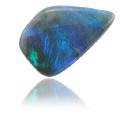Despite some e-mails telling me I left Opals out of the Orgainic Gemstone write-up, I must content Opals are not Organic.
The Opal has been a popular gem for many centuries and has a very interesting structure. Opal is considered a mineraloid because this structure is not truly crystalline. The chemistry of Opal is primarily SiO2 and varying amounts of water. The amount of water varies from 5 -10% and greater. This water can help geologists determine the temperature of the host rock at the time the opal formed.
.
Although there is no crystal structure, (meaning a regular arrangement of atoms) opal does possess a structure nonetheless. Random chains of silicon and oxygen are packed into extraordinarily tiny spheres. These spheres in most Opals are irregular in size and inconsistent in concentration. Yet in Precious Opal, the variety used most often in jewelry, there are many organized pockets of the spheres. These pockets contain spheres of approximately equal size and have a regular concentration, or structure, of the spheres. This has the effect of diffracting light at various wavelengths, creating colors. Each pocket produces a different color and with a different intensity, depending on the angle from which a viewer sees it. The multicolored flashes of light that Opal emits gives it a truly beautiful and valuable look. This effect is called a "play of light", and not "opalescence". The latter term describes the milky nature of the translucence of opal, and is more properly compared to the appearance of water to which a few drops of milk have been added.
Although there is no crystal structure, (meaning a regular arrangement of atoms) opal does possess a structure nonetheless. Random chains of silicon and oxygen are packed into extraordinarily tiny spheres. These spheres in most Opals are irregular in size and inconsistent in concentration. Yet in Precious Opal, the variety used most often in jewelry, there are many organized pockets of the spheres. These pockets contain spheres of approximately equal size and have a regular concentration, or structure, of the spheres. This has the effect of diffracting light at various wavelengths, creating colors. Each pocket produces a different color and with a different intensity, depending on the angle from which a viewer sees it. The multicolored flashes of light that Opal emits gives it a truly beautiful and valuable look. This effect is called a "play of light", and not "opalescence". The latter term describes the milky nature of the translucence of opal, and is more properly compared to the appearance of water to which a few drops of milk have been added.
.
.
.
.
Please check my write-up from 10/07/2008 for more about Opals, especially Australian Opals.
.
.
Thanks to Galleries.com for additional information on the Opal characteristics.
.
.



